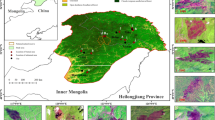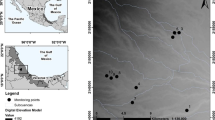Abstract
The Pinacate region is part of the Gran Desierto, one of the driest deserts in North America. The presence-absence of perennial plant species, together with soil and landform characteristics, were registered in 110 sampling sites within this region. A classification and ordination of plant communities showed soil and landform units to be good predictors of plant variation. Plant distribution and species richness were also strongly related to altitude and rockiness. A Generalised Linear Model was used to fit the response curves of individual species.
The environmental factors related with plant distribution are indicators of the water regime within a given site. Plant communities repeat along topographic gradients the large-scale biogeographic variation of the Sonoran Desert. Microphyllous shrubs colonise the drier bajada slopes, while more diverse communities, dominated by cacti and drought-deciduous trees, grow on the wetter pediments and in pockets within rocky soils.
Similar content being viewed by others
References
Arvidson, R. E. & Mutch, T. A., 1974. Sedimentary patterns in and around craters from the Pinacate volcanic field, Sonora, Mexico: some comparisons with Mars. Geol. Soc. America Bull. 85: 99–104.
Austin, M. P. & Cunningham, R. B., 1981. Observational analysis of environmental gradients. Proc. Ecol. Soc. Aust. 11: 109–119.
Austin, M. P., Cunningham, R. B. & Fleming, P. M., 1984. New approaches to direct gradient analysis using environmental scalars and statistical curve-fitting procedures. Vegetatio 55: 11–27.
Austin, M. P., Cunningham, R. B. & Good, R. B., 1983. Altitudinal distribution of several eucalypt species in relation to other environmental factors in southern New South Wales. Aust. J. Ecol. 8: 169–180.
Barbour, M. G. & Diaz, D. V., 1973. Larrea plant communities on bajada and moisture gradients in the United States and Argentina. Vegetatio 28: 335–352.
Bloom, A. L., 1978. Geomorphology. Prentice-Hall, New York.
Brown, J. H., Reichman, O. J. & Davidson, D. W., 1979. Granivory in desert ecosystems. Ann. Rev. Ecol. Syst. 10: 201–227.
Bull, W. B., 1974. Playa processes in the volcanic craters of the Sierra Pinacate, Sonora, Mexico. Z. Geomorph. 20 (Suppl.): 117–129.
Cortès, E. A., Fernàndez, M. A., Franco, E. M. & Vera, E., 1976. Geología del área volcánica del Pinacate en el Desierto de Altar, Sonora, México. Unpublished thesis, Instituto Politécnico Nacional, Mexico.
Davidson, D. W., Brown, J. H. & Inouye, R. S., 1980. Competition and the structure of granivore communities. Bioscience 30: 233–238.
Ezcurra, E., 1984. The vegetation of El Pinacate, Sonora. A quantitative study. Unpublished Ph.D. Thesis, University College of North Wales, Bangor, U.K.
Ezcurra, E., 1987. A comparison of reciprocal averaging and noncentred principal components analysis. Vegetatio 71: 41–47.
Ezcurra, E. & Equihua, M., 1984. La teoría de la información aplicada a la clasificación de datos biológicos. In: Ezcurra, E., Equihua, M., Kohlmann, B. & Sánchez, S. (eds). Métodos cuantitativos en la Biogeografia, pp. 13–39. Instituto de Ecología, Mexico.
Ezcurra, E. & Rodrigues, V., 1986. Rainfall patterns in the Gran Desierto, Sonora, Mexico. J. Arid Envir. 10: 13–28.
FAO-UNESCO 1974. Soil map of the world. Vol. 1, Legend. Paris.
Felger, R. S., 1980. Vegetation and flora of the Gran Desierto, Sonora, Mexico. Desert Plants 2: 87–114.
FitzPatrick, E. A., 1980. Soils. Their formation, classification and distribution. Longman, London.
Fonteyn, P. J. & Mahall, B. E., 1981. An experimental analysis of structure in a desert plant community. J. Ecol. 69: 883–896.
Gillison, A. N. & Brewer, K. R. W., 1985. The use of gradient directed transects or gradsects in natural resource surveys. J. Envir. Manag. 20: 103–127.
Gutmann, J. T., 1976. Geology of Crater Elegante, Sonora, Mexico. Geol. Soc. America Bull. 87: 1718–1729.
Hastings, J. R. & Turner, R. M., 1972. The Changing Mile. An ecological study of vegetation change with time in the lower mile of an arid and semiarid region. The Univ. of Arizona Press, Tucson.
Hayden, J. D., 1967. Summary of prehistory and history of the Sierra Pinacate, Sonora. Amer. Antiquity 32: 335–344.
Hayden, J. D., 1969. Gyratory crushers of the Sierra Pinacate, Sonora. Amer. Antiquity 34: 154–161.
Hayden, J. D., 1976. Pre-altithermal archaeology in the Sierra Pinacate, Sonora, Mexico. Amer. Antiquity 41: 274–289.
Hayden, J. D., 1982. Ground figures of the Sierra Pinacate, Sonora, Mexico. In: McGuire, R. H. & Schiffer, M. B. (eds). Hohokam and Patayan: prehistory of southern Arizona. pp. 581–595. Academic Press, New York.
Hill, M. O., 1973. Diversity and evenness: a unifying notation and its consequences. Ecology 54: 427–432.
Inouye, R. S., Byers, G. S. & Brown, J. H., 1980. Effects of predation and competition on survivorship, fecundity, and community structure of desert annuals. Ecology 61: 1344–1351.
Ives, R., 1955. Vegetative changes at Pinacate, Sonora, Mexico. Science 122: 135.
Ives, R., 1959. Shell dunes of the Sonoran shore. Am. J. Sci. 257: 449–457.
Ives, R., 1964. The Pinacate region, Sonora, Mexico. Occas. Papers Calif. Acad. Sci. 47: 1–43.
Lance, G. N. & Williams, W. T., 1968. Note on a new information statistic classificatory program. Computer J. 11: 195.
Lynch, D. J., 1982. Volcanic processes in Arizona. Field Notes, Ariz. Bur. Geol. Min. Technol. 12: 1–9.
Martin, S. C. & Turner, R. M., 1977. Vegetation change in the Sonoran Desert region, Arizona and Sonora. J. Ariz. Acad. Sci. 12: 59–69.
May, L. A., 1973. Resource reconnaissance of the Gran Desierto. Unpublished M.Sc. Thesis, Univ. of Arizona, Tucson.
McCullagh, P. & Nelder, J. A., 1983. Generalized Linear Models. Chapman and Hall, London.
McKee, E. D. & Breed, C. S., 1976. Sand seas of the world. In: Williams, R. S. & Carter, W. D. (eds). ERTS-1. A new window on our planet. U.S.G.S. Prof. Paper 929. pp. 81–88.
Merriam, R., 1969. Source of sand dunes of southeastern California and northwestern Sonora. Mexico. Geol. Soc. Am. Bull. 80: 531–534.
Merriam, R., 1972. Reconnaissance geologic map of the Sonoyta quadrangle. Northwestern Sonora, Mexico. Geol. Soc. Am. Bull. 83: 3533–3583.
Nelder, J. A. & Wedderburn, R. W. M., 1972. Generalized linear models. J. R. Statist. Soc. A, 135: 370–384.
Noy-Meir, I., 1973. Data transformation in ecological ordination: I. Some advantages of non-centering. J. Ecol. 61: 329–341.
Noy-Meir, I., Walker, D. & Williams, W. T., 1975. Data transformation in ecological ordination: II. On the meaning of data standardization. J. Ecol. 63: 779–800.
Olsvig-Whittaker, L., Shachak, M. & Yair, A., 1983. Vegetation patterns related to environmental factors in a Negev Desert watershed. Vegetatio 54: 153–165.
Rényi, A., 1961. On measurements of entropy and information. In: Neyman, J. (ed.). 4th. Berkeley Symposium on Mathematical Statistics and Probability, Berkeley. Vol. 1, pp. 547–561.
Shreve, F. & Wiggins, I. L., 1964. Vegetation and flora of the Sonoran Desert. Stanford Univ. Press, Standford.
Sokal, R. R. & Rohlf, F. J., 1969. Biometry, W. H. Freeman & Co., San Francisco.
Yang, T. W. & Lowe, C. H., 1956. Correlation of major vegetation climaxes with soil characteristics in the Sonoran Desert. Science 123: 542.
Yeaton, R. I., 1978. A cyclical relationship between Larrea tridentata and Opuntia leptocaulis in the northern Chihuahuan Desert. J. Ecol. 66: 651–656.
Author information
Authors and Affiliations
Rights and permissions
About this article
Cite this article
Ezcurra, E., Equihua, M. & Lopez-Portillo, J. The desert vegetation of El Pinacate, Sonora, Mexico. Vegetatio 71, 49–60 (1987). https://doi.org/10.1007/BF00048511
Accepted:
Issue Date:
DOI: https://doi.org/10.1007/BF00048511




